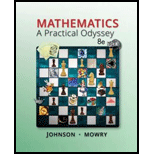
Mathematics: A Practical Odyssey
8th Edition
ISBN: 9781305104174
Author: David B. Johnson, Thomas A. Mowry
Publisher: Cengage Learning
expand_more
expand_more
format_list_bulleted
Question
Chapter B, Problem 35E
To determine
(a)
To calculate:
The value of
To determine
(b)
To calculate:
The value of
To determine
(c)
To calculate:
The value of
Expert Solution & Answer
Want to see the full answer?
Check out a sample textbook solution
Students have asked these similar questions
Part A) Internal telephone numbers in a university are composed of 5 digits. The first two digits can form any integer between (and including) 61 and 75, the third digit is an integer between 1 and 9, and the last two each take any integer value. Assume that it is disallowed to have a phone number with the last three digits being 999, 995, 911, or 100.
What is the total number of possible internal telephone numbers that start with the digit 6?
Part B) A system is composed of 6 components (A, B, C, D, E, F), each of which is either working or failed. The probability that a component is working is 0.54. Suppose the system will work if components A and B are both working, or if components E and F are both working. Find the probability that the system is working.
The question is on harvesting (mathematical biology). How did they get that highlighted part?
Answer this question with explanation
2. A social media account requires a 6-character password. Passwords should only contain numbers from 1 to 9 and capital letters A to E. How many different passwords can you generate
a. if the characters should not repeat?
b. if the characters repeat?
c. if the first 3 characters are numbers and the last 3 characters are letters, which are all distinct?
Chapter B Solutions
Mathematics: A Practical Odyssey
Ch. B - In Exercises 1-32, use your calculator to perform...Ch. B - Prob. 2ECh. B - Prob. 3ECh. B - Prob. 4ECh. B - Prob. 5ECh. B - Prob. 6ECh. B - Prob. 7ECh. B - Prob. 8ECh. B - Prob. 9ECh. B - Prob. 10E
Ch. B - Prob. 11ECh. B - Prob. 12ECh. B - Prob. 13ECh. B - Prob. 14ECh. B - Prob. 15ECh. B - Prob. 16ECh. B - Prob. 17ECh. B - Prob. 18ECh. B - Prob. 19ECh. B - Prob. 20ECh. B - Prob. 21ECh. B - Prob. 22ECh. B - Prob. 23ECh. B - Prob. 24ECh. B - Prob. 25ECh. B - Prob. 26ECh. B - Prob. 27ECh. B - Prob. 28ECh. B - Prob. 29ECh. B - Prob. 30ECh. B - Prob. 31ECh. B - Prob. 32ECh. B - Prob. 33ECh. B - Prob. 34ECh. B - Prob. 35ECh. B - Prob. 36ECh. B - Prob. 37ECh. B - Prob. 38ECh. B - Prob. 39ECh. B - Prob. 40ECh. B - Prob. 41ECh. B - Prob. 42ECh. B - a.What is the result of typing 8.1EE4? b.What is...
Knowledge Booster
Similar questions
arrow_back_ios
arrow_forward_ios
Recommended textbooks for you
 Holt Mcdougal Larson Pre-algebra: Student Edition...AlgebraISBN:9780547587776Author:HOLT MCDOUGALPublisher:HOLT MCDOUGAL
Holt Mcdougal Larson Pre-algebra: Student Edition...AlgebraISBN:9780547587776Author:HOLT MCDOUGALPublisher:HOLT MCDOUGAL

Holt Mcdougal Larson Pre-algebra: Student Edition...
Algebra
ISBN:9780547587776
Author:HOLT MCDOUGAL
Publisher:HOLT MCDOUGAL